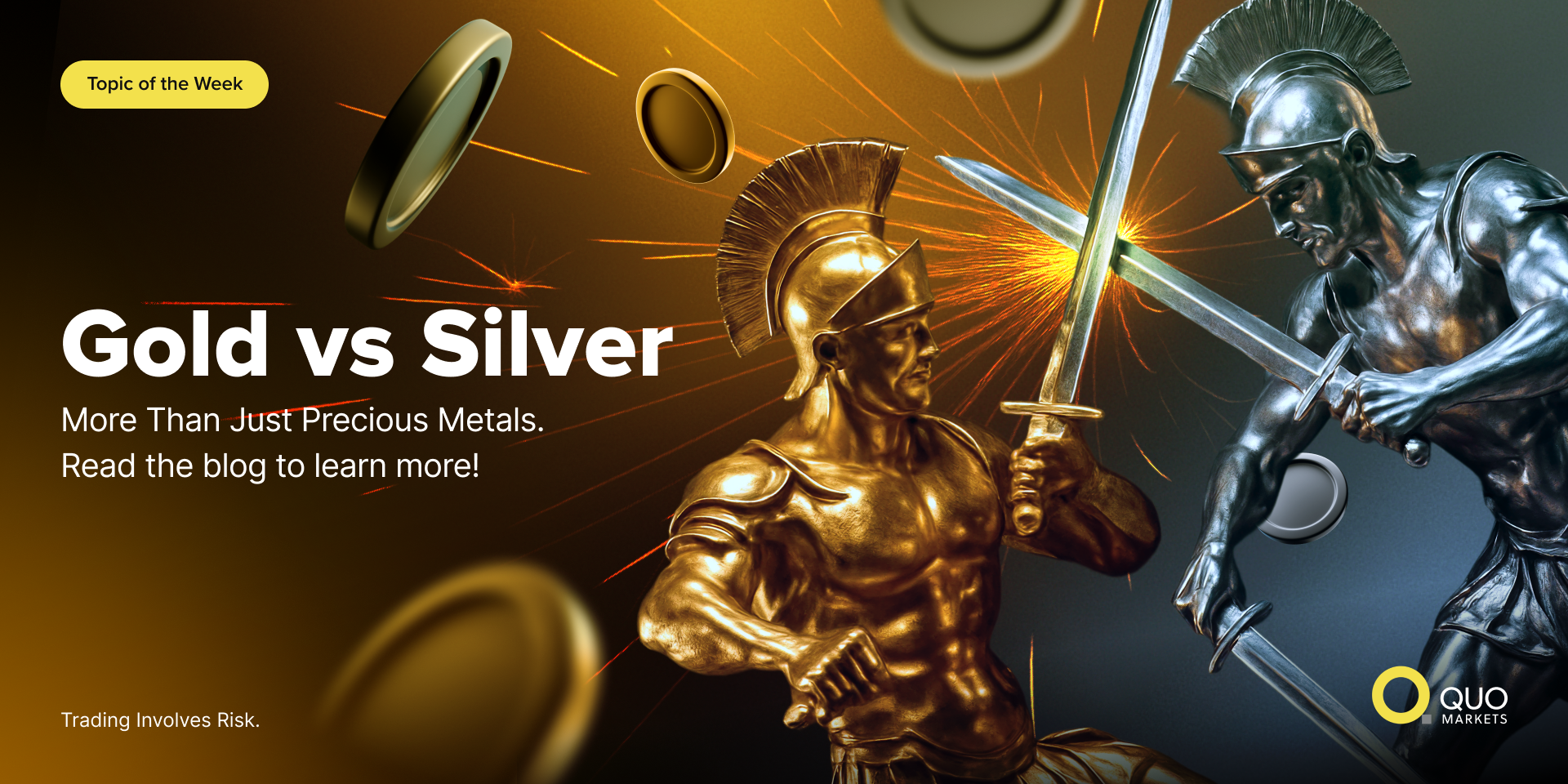Precious metals have always played a central role in financial markets, serving as both investment vehicles and stores of value. At QuoMarkets, we recognise the importance of educating traders and investors about how gold and silver can strengthen a diversified portfolio. While gold, often called the yellow metal, is the headline act, silver carries unique opportunities that are too often underestimated, especially in the silver vs gold debate.
Understanding the differences between gold and silver, along with how they behave under different economic conditions, is key to building an investment strategy that balances risk and potential reward aligned with your investment objectives. In this article, we compare gold and silver in detail, highlight their roles in modern portfolios, and provide actionable insights on how investors can trade them effectively with QuoMarkets, including via exchange traded funds and mutual funds.
Why Precious Metals Still Matter in 2025
Despite the rise of cryptocurrencies, digital assets, and complex derivatives, gold and silver remain cornerstones of wealth preservation and portfolio stability. Their appeal is not only rooted in history but also in their ability to hedge against inflation, protect purchasing power, and diversify exposure away from equities or fiat currency volatility and other asset classes.
In 2025, global inflation levels remain elevated across major economies, and interest rates, while stabilizing, continue to affect investor confidence in traditional assets. This environment has increased demand for non correlated assets like gold and silver. Investors want to preserve wealth while also hedging against potential downturns in stock markets or fiat currencies.
At QuoMarkets, we have seen strong interest from both beginner and professional traders looking to allocate part of their capital into gold and silver, as well as mining stocks related to these metals. The reasons are clear. Precious metals hedge against inflation as both tend to hold or increase value during inflationary periods. They are safe haven assets, with gold especially attracting capital during times of political or economic uncertainty. They also provide portfolio diversification, since metals are not directly tied to stock or bond performance.
Price and Accessibility: Gold vs Silver
Gold has historically commanded a far higher price than silver. In 2025, gold prices continue to trade well above 3,000 US dollars per ounce, making it attractive to institutional investors, sovereign funds, and high net worth individuals. Its high cost often makes it the preferred choice for those seeking long term stability and wealth preservation.
Silver, on the other hand, trades above 40 US dollars per ounce in 2025, making it far more accessible for retail investors. This lower price point allows traders with smaller budgets to gain exposure to precious metals without needing substantial capital. Silver coins and silver bars remain affordable options for individuals beginning their investment journey.
Industrial Demand and Real World Utility
Where gold is largely valued for investment and jewellery, silver stands out for its wide industrial usage.
Silver is essential for electronics and circuit production, serving as one of the best conductors of electricity. It is also a core component in solar panel manufacturing, with demand expected to rise as governments expand renewable energy projects. Medical industries rely on silver for its antibacterial properties, with applications ranging from surgical instruments to advanced coatings.
Green energy expansion is also boosting silver demand. With the global push for clean technologies, the use of silver in batteries, electric vehicles, and industrial equipment has increased in 2025. This industrial dependency makes silver prices sensitive to global growth cycles, offering both opportunity and volatility for traders.
Volatility and Market Behaviour
Gold is renowned for its stability and role as a safe haven asset. Investors often use it to offset risks in equities, currencies, and government debt markets. Its price movements are less volatile, which is why central banks continue to add gold to their reserves.
Silver, however, is more volatile because it is tied to both investment and industrial demand. In 2025, silver’s volatility has been amplified by fluctuations in global manufacturing, energy demand, and supply chain constraints. This makes silver attractive for active traders who want to take advantage of short term price swings.
Historical Perspective: The Gold to Silver Ratio
The gold to silver ratio measures how many ounces of silver equal one ounce of gold. Historically, this ratio has ranged from 30:1 to over 100:1. In 2025, the ratio hovers around 80, indicating that silver may still be undervalued relative to gold.
A high ratio above 80 may suggest that silver is underpriced and could present a buying opportunity. A low ratio below 50 often indicates that gold is undervalued. Traders who watch this ratio can identify opportunities to rebalance their holdings depending on market conditions.
Portfolio Strategy: Blending Stability with Growth
For a balanced portfolio, many investors combine gold and silver. Gold provides long term stability and security, while silver offers more growth potential due to industrial demand. This combination allows investors to manage risk while maintaining exposure to upside opportunities.
Understanding Physical Precious Metals: Bars and Coins
Investing directly in physical precious metals remains a popular choice for many investors looking to hold tangible assets. Gold bars and silver bars are widely recognized forms of physical bullion that offer a straightforward way to gain exposure to these two metals. Gold bars typically come in a variety of sizes, from small one-gram bars suitable for beginners to large 400-ounce bars favored by institutional investors. Silver bars are generally larger, often available in 100-ounce or 1000-ounce sizes, making them more affordable on a per-ounce basis compared to gold bars.
Physical precious metals provide a sense of security as they can be held outside of the financial system, offering protection against market fluctuations and financial crises. However, owning physical metals requires secure storage, insurance coverage, and considerations around liquidity when selling. Many investors choose to store their metals in professional vaults or safety deposit boxes to mitigate risks of theft or loss.
Market Fluctuations and Economic Climate Impact
Both gold and silver prices are influenced by market fluctuations driven by economic growth, interest rates, and political developments. During periods of high inflation or economic uncertainty, investors tend to flock to gold as a safe haven asset, seeking stability and preservation of wealth. Silver, while also benefiting from inflationary pressures, is more sensitive to economic growth due to its industrial applications.
The economic climate plays a crucial role in determining the performance of these metals. For example, during economic expansions, industrial demand for silver rises, supporting higher silver prices. Conversely, during market downturns, gold often outperforms as investors seek safety.
Understanding these dynamics helps investors make informed decisions about when to buy gold or silver and how to balance their portfolios across different asset classes.
Balancing Portfolio Risk with Precious Metals
Precious metals serve as effective tools for portfolio risk management. Gold’s reputation as a safe haven asset makes it a preferred choice for hedging against market downturns and rising inflation. Silver’s dual role as both an investment asset and an industrial metal offers growth potential but comes with higher volatility.
Investors tend to allocate a portion of their portfolios to precious metals to diversify holdings and reduce exposure to equities and bonds. The specific allocation depends on individual financial goals, risk tolerance, and market outlook.
Future Outlook: Navigating Market Uncertainty
Looking ahead, the precious metals market is expected to remain influenced by factors such as rising inflation, geopolitical tensions, and shifts in economic growth. Central banks’ policies regarding gold reserves and the pace of technological advancements impacting silver’s industrial uses will also shape market trends.
Investors should stay informed about these developments and consider how precious metals fit into their broader financial strategies.
While gold and silver offer unique benefits, it is important to remember that past performance is not indicative of future results. Market fluctuations can lead to periods of volatility, and no investment is without risk.
Five Year Outlook: Where Will Gold and Silver Be?
Will Gold Keep Its Safe Haven Status?
Yes. Gold’s role as a store of value is unlikely to change. Central banks continue to hold gold reserves, and demand remains strong across markets such as China and India. Analysts expect gold to maintain resilience, particularly if inflation pressures persist or geopolitical risks intensify.
Can Silver Benefit from the Green Energy Boom?
Silver’s industrial demand is set to grow significantly due to solar energy expansion, electric vehicle production, and clean technology adoption. This demand is expected to put upward pressure on silver prices over the next five years, positioning it as a growth asset for forward looking investors.
Should I Invest in Both?
Yes. Combining both provides balance, with gold delivering stability and silver offering growth potential. At QuoMarkets, our platform makes it simple to access both metals from a single account, whether through physical bullion, exchange traded funds, or CFDs.
Frequently Asked Questions
What is the gold to silver ratio, and why should I care?
It measures how many ounces of silver equal one ounce of gold. A high ratio signals silver may be undervalued, while a low ratio may suggest gold is undervalued.
Is silver riskier than gold?
Yes, silver is more volatile due to industrial demand. However, volatility also creates opportunities for higher returns.
Can I trade gold and silver at QuoMarkets?
Absolutely. QuoMarkets offers CFDs on both, allowing you to speculate on price movements without physical ownership. Traders also benefit from zero spread on gold and enjoy zero fees on withdrawals, making it more cost effective to manage and grow your portfolio.
What will gold and silver prices look like in five years?
While forecasts are never guaranteed, gold is expected to remain resilient due to its safe haven appeal. Silver is likely to benefit from renewable energy growth, though it will remain more volatile.
Should beginners start with silver or gold?
At QuoMarkets, both options are accessible. Silver gives beginners affordability and flexibility, while gold provides long term confidence and stability. With CFDs on both metals, zero spread on gold, and no withdrawal fees, QuoMarkets makes it simple for beginners to choose the pathway that aligns best with their financial goals.
Key Takeaways
Gold represents stability, a hedge against inflation, and long term wealth preservation. Silver provides affordability, volatility, and growth potential through industrial demand. Both metals can strengthen diversification and reduce overall portfolio risk.
QuoMarkets provides seamless access to gold and silver trading through CFDs, alongside education and support to help traders make smarter decisions.
Gold and silver remain two of the most valuable and time tested assets available to investors in 2025. By understanding their differences and incorporating them strategically, investors can build portfolios that withstand uncertainty while positioning for growth.
*Disclaimer: This article is for informational purposes only and does not constitute financial advice. Please consult a qualified financial advisor before making investment decisions.





